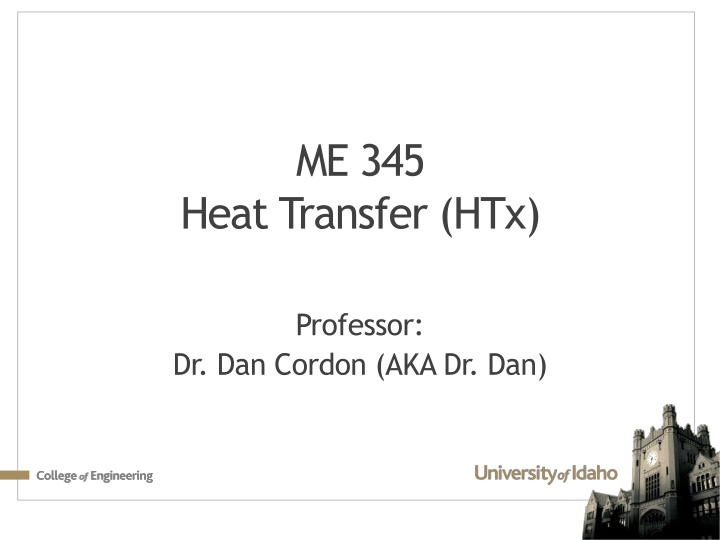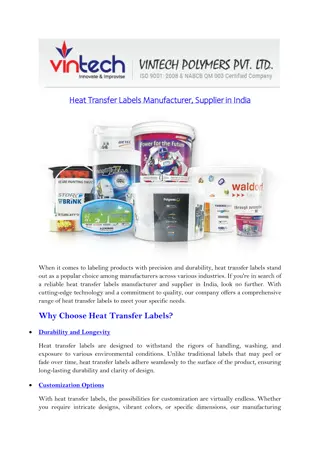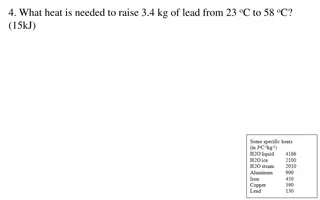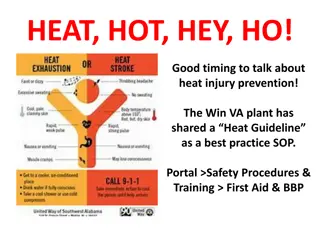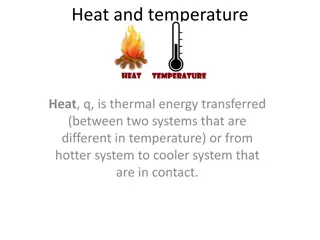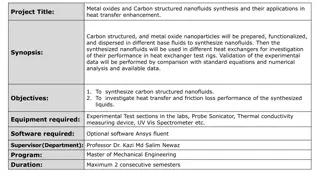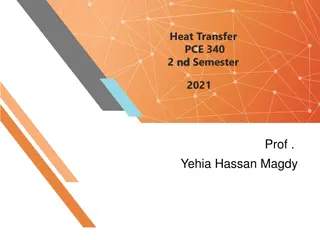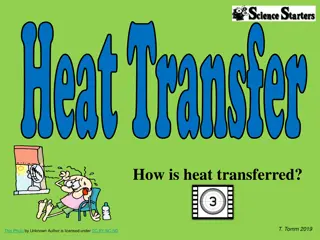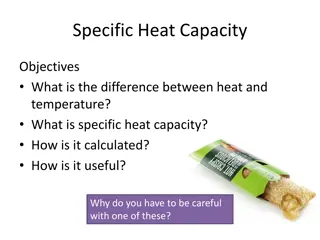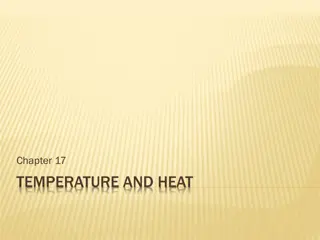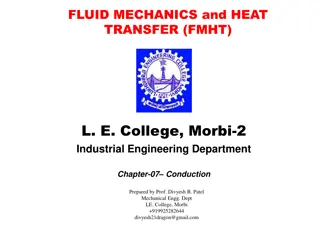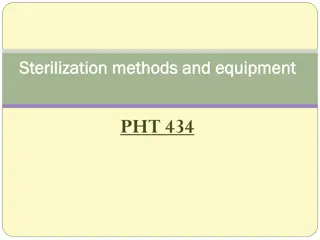Heat Transfer in Practical Applications
Explore thermal resistance problems in heat transfer focusing on conduction, convection, and radiation. Solve scenarios involving defrosting car windows and maintaining glass temperature with film heaters. Understand key equations and assumptions to determine surface temperatures and required power.
Download Presentation

Please find below an Image/Link to download the presentation.
The content on the website is provided AS IS for your information and personal use only. It may not be sold, licensed, or shared on other websites without obtaining consent from the author.If you encounter any issues during the download, it is possible that the publisher has removed the file from their server.
You are allowed to download the files provided on this website for personal or commercial use, subject to the condition that they are used lawfully. All files are the property of their respective owners.
The content on the website is provided AS IS for your information and personal use only. It may not be sold, licensed, or shared on other websites without obtaining consent from the author.
E N D
Presentation Transcript
ME 345 Heat Transfer (HTx) Professor: Dr. Dan Cordon (AKA Dr. Dan)
Solving Thermal Resistance Problems Draw the thermal circuit Use appropriate equation for thermal resistance Geometry Conduction/Convection/Radiation Identify which variables are known and unknown Choose your solution approach (calculator and hand calculations vs. software)
Textbook Problem 3.3 A 4mm thick front window of a car is defrosted by passing warm (dry) air over the inner surface. If the inside air is 40 [ C] with convection coefficient of 30 [W/m2K] and the outside air is -10 [ C] with convection coefficient of 65 [W/m2K] calculate the inside and outside surface temperature of the glass Is this enough to keep ice from forming on the outside of the glass?
Textbook Problem 3.3 Assumptions: 1D SS conduction through the window Material properties not changing with temperature Radiation HTx is negligible Known
Textbook Problem 3.3 Use equations 3.11 and 3.12 Look up thermal conductivity for glass Table A-3, glass at 300 [K], k = 1.4 [W/m-K] Heat flux (because area unknown) can be expressed by:
Textbook Problem 3.3 With known heat flux, can evaluate temperature drop across each resistance At the inner surface ? = ?(? ,? ??,?) At the outer surface ? = ?(??,? ? ,?)
Textbook Problem 3.4 Similar problem as 3.3, except now a film heater is applied to inside surface of the window. If the inside air is 25 [ C] with convection coefficient of 10 [W/m2K] and the outside air is -10 [ C] with convection coefficient of 65 [W/m2K]. Want to maintain inner glass temperature of 15 [ C]. Calculate the heater power required per unit area
Textbook Problem 3.4 Assumptions: 1D SS conduction through the window Material properties not changing with temperature Radiation HTx is negligible Film heater is thin and highly-conductive (negligible thermal resistance)
Textbook Problem 3.4 Energy balance (flux) at the inner surface of the window Solving for heater heat flux:
Textbook Problem 3.12 Thermopane window on a house is made of two pieces of 7 [mm] thick glass with a 7 [mm] thick air space between them. The inside and outside temperatures are 20 [ C] and -10 [ C]. The interior convection coefficient is 10 [W/m2K], while the outer is 80 [W/m2K]. Calculate the heat loss rate through a window that is 0.8 [m] tall and 0.5 [m] wide. Repeat for a triple pane style window
Textbook Problem 3.12 Assumptions: 1D SS conduction through the window Material properties not changing with temperature Radiation HTx is negligible Air in gap is stagnant Known
Textbook Problem 3.12 Use equations 3.11 and 3.12 Look up thermal conductivities Table A-3, glass at 300 [K], k = 1.4 [W/m-K] Table A-4, air at 278 [K], k = 0.0245 [W/m-K]
Textbook Problem 3.12 For the triple pane, total thermal resistance increases to 1.749 [K/W], and the heat loss drops to 17.2 [W]
Textbook Problem 3.24 Firefighter protective turnout coat is typically made of three layers with air gap between each layer. Create the thermal circuit for this boat. Note: Since radiation heat transfer is significant, include these terms in your thermal circuit.
Textbook Problem 3.24 Some interesting approximations for the radiation thermal resistance This was used to make the calculations easier, and comes from assuming epsilon = 1 (worst-case that would represent maximum heat transferred through radiation) The radiation thermal resistance can be modeled as
Textbook Problem 3.46 A cylindrical water heater (100 gallon) uses urethane foam insulation around the outside. The water inside is 55 [ C] and the air temperature outside the heater is 20 [ C]. The convection coefficient between the air and tank is 2 [W/m2K] (low because it is only from natural convection). If electrical power costs $0.18 / kW-hr, specify dimensions for both the tank *and* insulation so that the annual cost of heat loss from the heater is less than $50.
Textbook Problem 3.46 Assumptions: 1D SS conduction Inner surface temperature is nearly the same as water temperature (metal tank) Neglect radiation (foil covering on insulation) Constant properties
Textbook Problem 3.46 Look up thermal conductivity Table A-3, urethane foam at 300 [K], k = 0.026 [W/m-K] To minimize heat loss we should minimize the surface area. When the height is defined by: ? =4 ??? ??2 Surface area of the cylinder is: ??2 4 +??2 4 ??? ? ????= ??? + 2 2
Textbook Problem 3.46 Minimize Asur by taking derivative with respect to diameter and setting equal to zero ????? ?? = 4 ??? ?2 + ?? = 0 We get 1/3 1/3 4 ??? ? 4 ??? ? ? = ??? ? = Since the tank is 100 gallons = 0.379 m3 we get: D = L = 0.784 [m]
Textbook Problem 3.46 Now that we have the dimensions we need to calculate the maximum allowable heat rate 50 ??????? 0.18??????? ?? ? ???????= = 278 ?? ? ??????? ???????= ???? ?? ? ????= 31.7 [?]
Textbook Problem 3.46 Heat loss through the side and ends is Cylinder wall Round ends Conduction Conduction Convection Convection
Textbook Problem 3.46 Solve for delta (insulation thickness) to get
Textbook Problem 3.46 Real-world reality check Water heaters are almost never built with L = D (stress analysis dictates this). Looking up some common dimensions for a 100 gallon water heater D ~ 0.623 [m], and L ~ 1.245 [m] Using same thickness for insulation and solving for rate of heat loss we get: q = 34 [W], and Annual Cost = $53.62
Textbook Problem 3.46 Are you bored? Run this same calculation for a spherical water heater. Benefit: Lower surface to volume ratio Any downsides?
